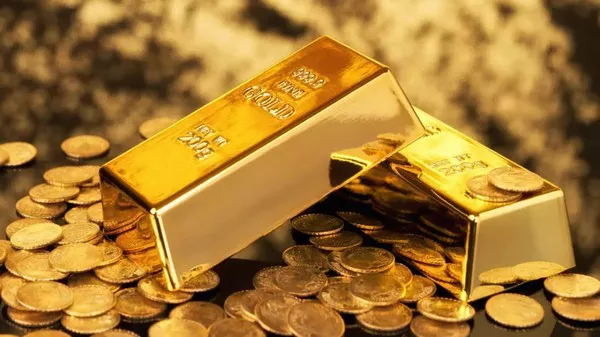Gold prices experienced a decline in Asian trading on Monday, continuing their losses from the previous week. This drop came as markets largely focused on positive risk sentiment spurred by Donald Trump’s victory in the 2024 U.S. presidential election. Additionally, the strength of the U.S. dollar and anticipation of upcoming economic data further pressured the yellow metal.
Spot gold prices fell by 0.5%, settling at $2,670.69 per ounce, while December gold futures dropped 0.1%, reaching $2,677.50 an ounce by 23:35 ET (04:35 GMT). These movements reflect a larger trend of declining gold prices as market expectations shifted in response to political and economic developments.
Trump’s Victory and Market Reaction
The significant loss in gold prices was largely attributed to the market’s positive reaction to Trump’s election victory. His win removed a major point of uncertainty, which had driven investors toward gold as a safe haven in previous weeks. As gold’s appeal waned, attention shifted to expectations surrounding Trump’s second term and its potential economic impact.
Trump’s administration is anticipated to implement more expansionary fiscal policies, which could lead to higher inflation in the long run. With inflation expected to remain elevated and interest rates likely to stay high, the outlook for gold remained pressured. Market participants interpreted these potential policy shifts as a sign that the yellow metal’s price rally, which had reached record highs, might be coming to an end.
The Federal Reserve and Economic Data
The Federal Reserve’s recent actions also played a role in gold’s downward trajectory. Last week, the central bank announced a 25 basis point cut in interest rates, signaling a cautious approach to further easing. Despite the Fed’s efforts to manage inflation, the expectation of long-term high interest rates under Trump’s leadership continued to weigh on gold prices.
This week, market participants are focusing on the release of the U.S. Consumer Price Index (CPI), a key indicator of inflation. Investors are looking for signs of whether inflation is cooling in line with the Federal Reserve’s expectations. The CPI data, scheduled for release later this week, will provide crucial insights into the future direction of both gold prices and U.S. monetary policy.
Additionally, the upcoming speeches of several Federal Reserve officials will offer further clues about the central bank’s approach to managing inflation and interest rates. These developments are likely to continue influencing gold prices in the near term, as the market reacts to the evolving economic landscape.
Limited Safe Haven Demand Despite Global Tensions
Even amid rising global tensions, gold saw limited safe haven demand. Over the weekend, news broke that Ukraine had launched a major drone strike on Moscow, escalating the ongoing conflict between Russia and Ukraine. However, the geopolitical situation did not spark a significant uptick in gold prices, which traditionally benefit from such risks.
This lack of significant movement in gold prices, despite the increased geopolitical risks, suggests that investor sentiment is currently more focused on economic factors, including inflation and the U.S. Federal Reserve’s policies, than on global security concerns.
Other Precious Metals Show Mixed Performance
While gold prices took a hit, other precious metals displayed mixed performance on Monday. Platinum futures saw a modest increase, rising by 0.4% to $983.05 per ounce. On the other hand, silver futures fell 0.5%, reaching $31.293 per ounce. These price fluctuations reflect the broader market sentiment toward precious metals, which is influenced by both economic data and geopolitical events.
Platinum’s rise could be linked to ongoing concerns about supply constraints, while silver’s decline may be due to the same broader economic pressures impacting gold prices. The performance of these metals, like gold, will remain closely tied to developments in U.S. inflation, the Federal Reserve’s actions, and global economic conditions.
Copper Prices Struggle Amid Underwhelming Chinese Stimulus
Turning to industrial metals, copper prices also faced challenges on Monday. Despite China’s announcement of significant new fiscal measures, copper prices remained under pressure, reflecting investor disappointment. Benchmark copper futures on the London Metal Exchange rose slightly by 0.1%, reaching $9,450 per ton, while December copper futures saw a small decline of 0.1%, settling at $4.3037 per pound.
China’s National People’s Congress recently approved about 10 trillion yuan ($1.4 trillion) in new debt measures, aimed at supporting local governments. However, the fiscal package fell short of investor expectations, especially given the recent data showing worsening deflation in China. This disappointment weighed on copper prices, as investors had hoped for more targeted fiscal stimulus to bolster demand for the metal.
China’s Economic Outlook Under Trump’s Presidency
Analysts at ANZ suggested that Beijing might be adopting a wait-and-see approach with its fiscal policies, particularly as it assesses how U.S. trade policy will evolve under Trump’s second term. Trump has consistently promised to impose steep trade tariffs on China, which could have significant implications for the country’s economy and its demand for commodities like copper.
In response to the disappointing fiscal measures, copper prices have struggled to regain momentum, with global economic uncertainties continuing to affect the outlook for industrial metals. Investors are closely monitoring China’s economic performance, as it remains the world’s largest copper importer, and any further signs of economic slowdown or policy shifts could lead to additional volatility in copper prices.
Conclusion
The decline in gold prices below the $2,700 mark reflects a broader shift in market sentiment following Donald Trump’s victory in the 2024 U.S. presidential election. With the removal of election-related uncertainty, investors are adjusting their expectations for inflation, interest rates, and U.S. economic policy under a Trump administration. These developments have tempered gold’s appeal as a safe haven, with the market now looking closely at U.S. inflation data and the Federal Reserve’s actions for further cues.
Meanwhile, other precious metals, such as platinum and silver, have exhibited mixed performances, while copper prices face downward pressure amid underwhelming fiscal stimulus measures in China. As global economic conditions continue to evolve, the performance of gold and other metals will remain closely tied to economic data, central bank policies, and geopolitical developments.
Related topics:

